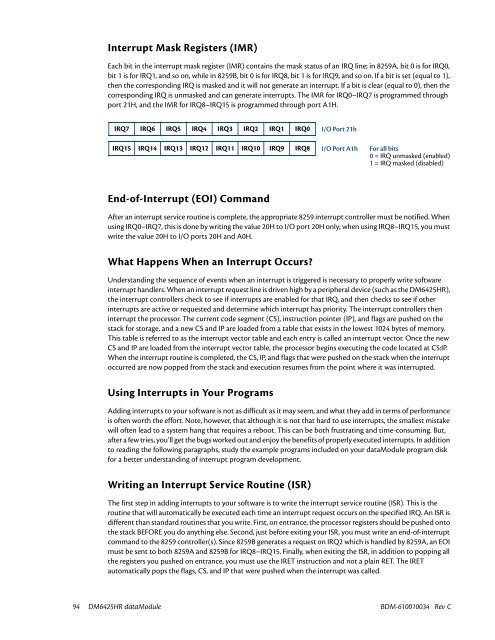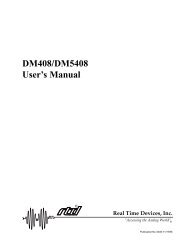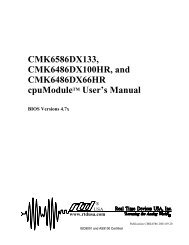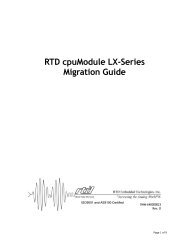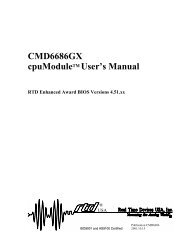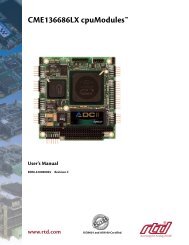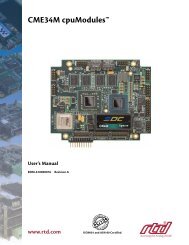Hardware Manual - RTD Embedded Technologies, Inc.
Hardware Manual - RTD Embedded Technologies, Inc.
Hardware Manual - RTD Embedded Technologies, Inc.
You also want an ePaper? Increase the reach of your titles
YUMPU automatically turns print PDFs into web optimized ePapers that Google loves.
Interrupt Mask Registers (IMR)<br />
Each bit in the interrupt mask register (IMR) contains the mask status of an IRQ line; in 8259A, bit 0 is for IRQ0,<br />
bit 1 is for IRQ1, and so on, while in 8259B, bit 0 is for IRQ8, bit 1 is for IRQ9, and so on. If a bit is set (equal to 1),<br />
then the corresponding IRQ is masked and it will not generate an interrupt. If a bit is clear (equal to 0), then the<br />
corresponding IRQ is unmasked and can generate interrupts. The IMR for IRQ0–IRQ7 is programmed through<br />
port 21H, and the IMR for IRQ8–IRQ15 is programmed through port A1H.<br />
IRQ7 IRQ6 IRQ5 IRQ4 IRQ3 IRQ2 IRQ1 IRQ0<br />
I/O Port 21h<br />
IRQ15 IRQ14 IRQ13 IRQ12 IRQ11 IRQ10 IRQ9 IRQ8 I/O Port A1h For all bits<br />
0 = IRQ unmasked (enabled)<br />
1 = IRQ masked (disabled)<br />
End-of-Interrupt (EOI) Command<br />
After an interrupt service routine is complete, the appropriate 8259 interrupt controller must be notified. When<br />
using IRQ0–IRQ7, this is done by writing the value 20H to I/O port 20H only; when using IRQ8–IRQ15, you must<br />
write the value 20H to I/O ports 20H and A0H.<br />
What Happens When an Interrupt Occurs?<br />
Understanding the sequence of events when an interrupt is triggered is necessary to properly write software<br />
interrupt handlers. When an interrupt request line is driven high by a peripheral device (such as the DM6425HR),<br />
the interrupt controllers check to see if interrupts are enabled for that IRQ, and then checks to see if other<br />
interrupts are active or requested and determine which interrupt has priority. The interrupt controllers then<br />
interrupt the processor. The current code segment (CS), instruction pointer (IP), and flags are pushed on the<br />
stack for storage, and a new CS and IP are loaded from a table that exists in the lowest 1024 bytes of memory.<br />
This table is referred to as the interrupt vector table and each entry is called an interrupt vector. Once the new<br />
CS and IP are loaded from the interrupt vector table, the processor begins executing the code located at CS:IP.<br />
When the interrupt routine is completed, the CS, IP, and flags that were pushed on the stack when the interrupt<br />
occurred are now popped from the stack and execution resumes from the point where it was interrupted.<br />
Using Interrupts in Your Programs<br />
Adding interrupts to your software is not as difficult as it may seem, and what they add in terms of performance<br />
is often worth the effort. Note, however, that although it is not that hard to use interrupts, the smallest mistake<br />
will often lead to a system hang that requires a reboot. This can be both frustrating and time-consuming. But,<br />
after a few tries, you’ll get the bugs worked out and enjoy the benefits of properly executed interrupts. In addition<br />
to reading the following paragraphs, study the example programs included on your dataModule program disk<br />
for a better understanding of interrupt program development.<br />
Writing an Interrupt Service Routine (ISR)<br />
The first step in adding interrupts to your software is to write the interrupt service routine (ISR). This is the<br />
routine that will automatically be executed each time an interrupt request occurs on the specified IRQ. An ISR is<br />
different than standard routines that you write. First, on entrance, the processor registers should be pushed onto<br />
the stack BEFORE you do anything else. Second, just before exiting your ISR, you must write an end-of-interrupt<br />
command to the 8259 controller(s). Since 8259B generates a request on IRQ2 which is handled by 8259A, an EOI<br />
must be sent to both 8259A and 8259B for IRQ8–IRQ15. Finally, when exiting the ISR, in addition to popping all<br />
the registers you pushed on entrance, you must use the IRET instruction and not a plain RET. The IRET<br />
automatically pops the flags, CS, and IP that were pushed when the interrupt was called.<br />
94 DM6425HR dataModule BDM-610010034 Rev C


